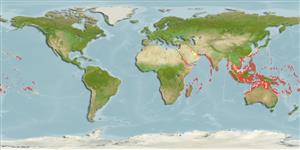Common names from other countries
Environment: milieu / climate zone / depth range / distribution range
Écologie
marin récifal; profondeur 0 - 60 m (Ref. 128797). Tropical; 35°N - 26°S, 32°E - 122°W
Indo-Pacific: Red Sea, East Africa eastward through northern Australia reaching to Line and Tuamotu islands, north to southern Japan.
Taille / Poids / Âge
Maturity: Lm ? range ? - ? cm
Max length : 75.0 cm TL mâle / non sexé; (Ref. 9710)
Épines dorsales (Total) : 3; Rayons mous dorsaux (Total) : 24 - 26; Épines anales: 0; Rayons mous anaux: 22 - 24. Fish has a deep grove before eye; scaleless area around lips, continuing and narrowing posterior to corner of mouth; small forward-curving spines in about five rows on side of and a short distance anterior to caudal peduncle. Caudal peduncle compressed (Ref. 9770).
Recorded from lagoons, seaward reefs (Ref. 1602) and sheltered inner reef slopes (Ref. 48637). Juveniles often associated with isolated patches of branching coral or rubble of shallow sandy protected areas. Adults occur singly or in pairs on the slopes of deep lagoon or seaward reefs (Ref. 37816, 48637). Often hostile towards divers and may attack unprovoked when caring for eggs (Ref. 48637). Feed on sea urchins, coral, crabs and other crustaceans, mollusks and tube worms. Oviparous (Ref. 205). Largest triggerfish; females are reported to have attacked divers when guarding their nest (Ref. 2334). Also caught with drive-in nets. Marketed fresh and dried-salted (Ref. 9770).
Life cycle and mating behavior
Maturities | Reproduction | Spawnings | Egg(s) | Fecundities | Larves
Distinct paring (Ref. 205).
Matsuura, K., 2001. Balistidae. Triggerfishes. p. 3911-3928. In K.E. Carpenter and V. Niem (eds.) FAO species identification guide for fishery purposes. The living marine resources of the Western Central Pacific. Vol. 6. Bony fishes part 4 (Labridae to Latimeriidae), estuarine crocodiles. FAO, Rome. (Ref. 9770)
Statut dans la liste rouge de l'IUCN (Ref. 130435)
CITES (Ref. 128078)
Not Evaluated
Menace pour l'homme
Reports of ciguatera poisoning (Ref. 1602)
Utilisations par l'homme
Pêcheries: commercial
Outils
Articles particuliers
Télécharger en XML
Sources Internet
Estimates based on models
Preferred temperature (Ref.
115969): 25 - 29, mean 28.1 (based on 1016 cells).
Phylogenetic diversity index (Ref.
82804): PD
50 = 0.7500 [Uniqueness, from 0.5 = low to 2.0 = high].
Bayesian length-weight: a=0.03311 (0.02062 - 0.05319), b=2.97 (2.83 - 3.11), in cm Total Length, based on LWR estimates for this species & (Sub)family-body (Ref.
93245).
Niveau trophique (Ref.
69278): 3.3 ±0.44 se; based on food items.
Résilience (Ref.
120179): Faible, temps minimum de doublement de population : 4,5 à 14 années (Preliminary K or Fecundity.).
Fishing Vulnerability (Ref.
59153): Moderate to high vulnerability (50 of 100).
